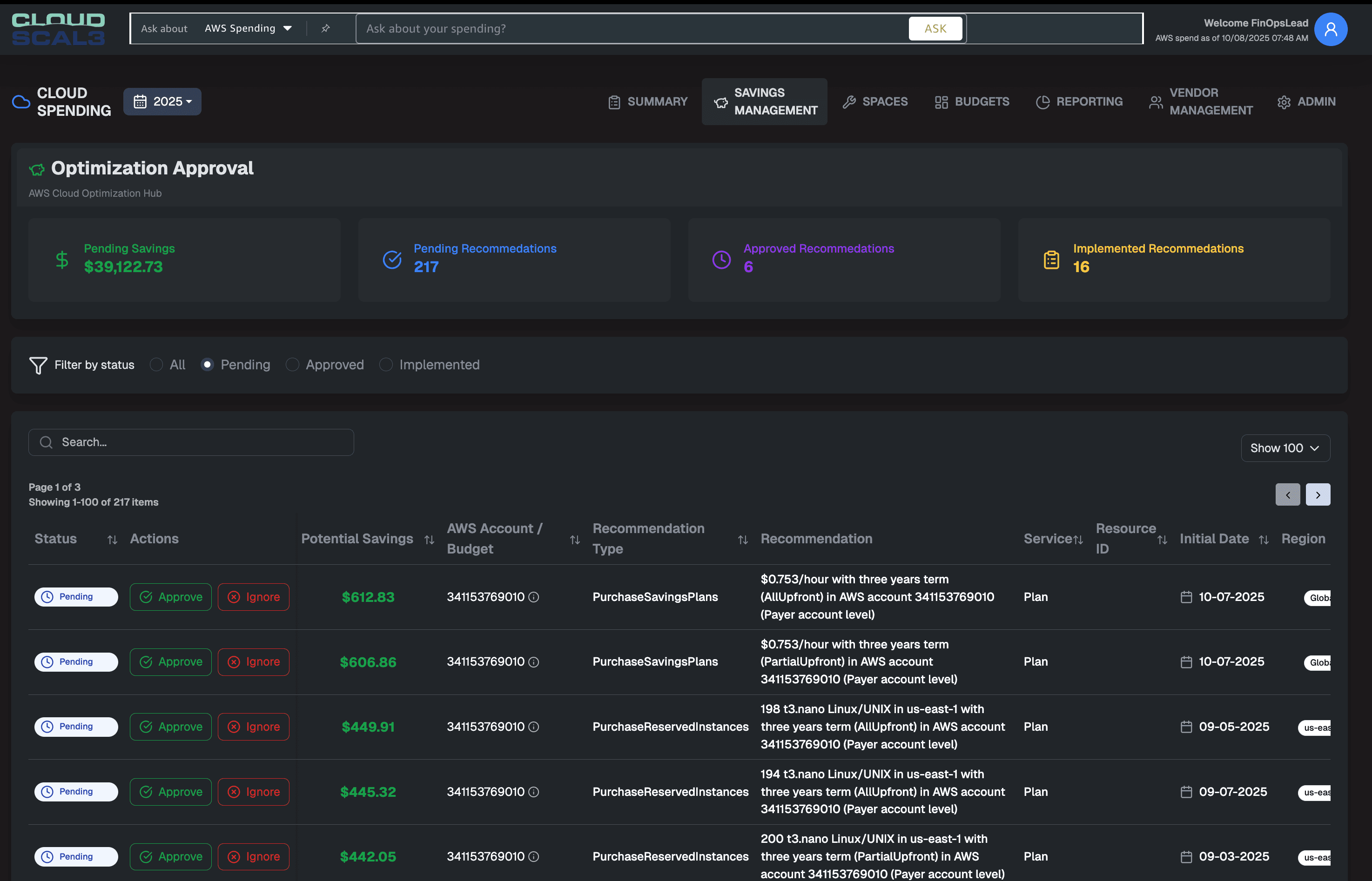
AWS Cost Optimization Hub Recommendations Now Available in FinOps Center
The new Savings Management Tab in FinOps Center is where the business team can provide guidance to cloud engineers on which cost optimization recommendations to execute and which to ignore.
In the world of Cloud Financial Management (CFM), the hardest part isn’t knowing that you can save money—it’s knowing where to act, who needs to approve it, and how to operationalize it. Cost optimization is often treated as a purely technical discipline, but the truth is that many of the savings opportunities inside AWS are business decisions first, not engineering challenges.
With the latest integration of AWS Cost Optimization Hub into FinOps Center, Cloud Scal3 is closing the gap between identification and execution—making cost optimization a collaborative, cross-functional process.
The Problem: Too Many Tools, Too Little Action
Organizations have long relied on external cost optimization tools, many of which charge significant fees to surface the same recommendations AWS already provides. These third-party dashboards often introduce more complexity, not less—requiring engineers to interpret results, chase approvals, and manage communication loops that stall decision-making.
Meanwhile, AWS’s own Cost Optimization Hub (COH) continues to evolve, offering increasingly comprehensive recommendations that help maximize your investment in AWS. The problem has never been about finding opportunities—it’s about managing them effectively across finance, vendor management, and engineering teams.
Traditional cost-optimization processes are buried in spreadsheets, emails, and screenshots from the AWS console. Finance teams often depend on Cloud Engineers to interpret whether a Savings Plan, Reserved Instance, or right-sizing recommendation is valid, even though many of those decisions fall within business governance—not technical engineering.
Enter FinOps Center: Centralized Cloud Financial Governance
FinOps Center was built to simplify the management of AWS spending by providing an integrated, role-based platform that aligns business, finance, and technical users around a single system of record.
With the new Cost Optimization Hub Integration, FinOps Center extends that mission by allowing organizations to see, approve, and track cost-saving recommendations directly within the application—without requiring access to the AWS console or deep technical knowledge.
For many teams, this is a major milestone: cost optimization can finally live where financial management decisions are made, not where EC2 instances are provisioned.Introducing the Savings Management Tab
The new Savings Management Tab in FinOps Center is where the business team can provide guidance to cloud engineers on which cost optimization recommendations to execute and which to ignore.
Every Financial Admin and Vendor Manager now has access to a unified view of all Savings Opportunities surfaced from the AWS Cost Optimization Hub. These opportunities are presented in a simplified interface—on both the Summary Page and the dedicated Savings Management Tab—so non-technical users can review and act on them directly.
Each recommendation in FinOps Center corresponds to a unique Recommendation ID from AWS. Just like in the console, these recommendations are generated daily and appear only once, ensuring users are always working from the latest snapshot. However, the same opportunity may reappear under a new ID if AWS reissues a refreshed recommendation.
Within FinOps Center, users can easily differentiate between Pending, Approved, Ignored, and Completed recommendations. The tab functions as a structured workflow that moves each recommendation from discovery to resolution—with clear visibility into which AWS Accounts and Budgets are impacted by each decision.
Empowering Financial Admins and Vendor Managers
The design principle behind this integration is simple: business and finance users should control business and financial decisions.
When a new Savings Plan or Reserved Instance recommendation appears, Financial Admins and Vendor Managers can review it directly in FinOps Center, along with contextual budget data. They immediately see which budgets are affected and can make informed decisions on whether the purchase aligns with organizational priorities.
If a recommendation is approved, it enters the implementation queue for Cloud Engineering. If it’s ignored, FinOps Center records that decision and removes the item from future views (unless AWS issues a new Recommendation ID).
This process transforms what was once a fragmented, manual, and technical workflow into a streamlined business approval cycle—bridging the gap between Finance and Engineering in a controlled, auditable way.
From Approval to Implementation
Once a recommendation is approved, it doesn’t disappear into the void. FinOps Center ensures traceability by allowing Admins to track implementation status directly within the platform.
In this first release, implementation remains a manual task for Cloud Engineers—but the groundwork is already in place for FinOps Center’s upcoming AI agent, Agent Bill, to automate many of these steps.
Agent Bill will soon be able to execute approved recommendations programmatically—purchasing Savings Plans, modifying reservations, or adjusting configurations through AWS APIs—eliminating the need for human hand-offs.
The long-term vision is a seamless “review → approve → implement” pipeline, where FinOps Center and Agent Bill handle the full lifecycle of AWS cost optimization decisions under the governance of your organization’s financial rules.
Reducing Cycle Time and Increasing Accountability
By integrating AWS Cost Optimization Hub directly into FinOps Center, organizations can reduce the cycle time between recommendation discovery and implementation dramatically.
Finance teams no longer need to request console screenshots. Engineers no longer need to interpret budget implications. Everyone operates within a unified view that ties recommendations to specific financial scopes, budgets, and business units.
This alignment ensures that cost optimization isn’t just about saving money—it’s about making financially intelligent decisions that align with operational and strategic priorities.
A Step Toward True Cloud Financial Automation
The FinOps journey has always been about turning awareness into action. With Cost Optimization Hub integration, FinOps Center moves one step closer to full automation.
Today, users can review and approve savings opportunities without ever logging into the AWS console. Tomorrow, Agent Bill will handle execution, verification, and reporting—creating a truly Agentic Cloud Financial Management experience.
For now, the Savings Management Tab marks a pivotal advancement in how organizations operationalize AWS Cost Optimization. It empowers financial users to take ownership, enables engineers to focus on higher-value work, and brings visibility and accountability to the core of cloud financial governance.